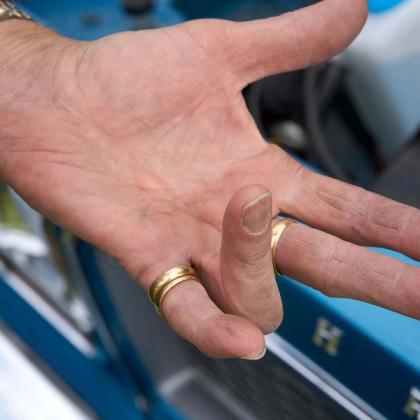Dupuytren’s disease is a chronic, progressive condition that primarily affects the palmar and digital fascia of the hand. Over time, fibrous cords form under the skin, thickening and contracting, which can cause the fingers (most often the ring and little fingers) to curl inward. This results in Dupuytren’s contracture, limiting hand function and impacting daily activities. It often starts with the formation of painless nodules in the palm. As the disease progresses, these nodules develop into cords that restrict finger movement. While the condition is not life-threatening, it can significantly affect a person’s quality of life and is a common presentation in general practice. In this episode, Dr Roger Henderson looks at the diagnosis of Dupuytren’s, its risk factors, usual management and some of the newer treatment techniques now available.
Key take-home points
- Dupuytren’s disease prevalence in Western countries ranges widely from 0.6 to 31%, but the overall prevalence in the UK is about 4%, increasing to about 20% in those aged over 65.
- It is more common in men than women, and incidence increases with age.
- The exact cause is still being studied, but research suggests that it is largely a genetic condition with a strong hereditary component.
- It is more commonly seen in individuals with diabetes or seizure disorders, heavy drinkers and those with a history of smoking.
- Significant exposure to hand-held vibrating tools can more than double the risk, but even heavy manual work without any vibration exposure may also increase the risk.
- The progression of Dupuytren’s disease follows three key phases: proliferative, involution and residual.
- Bilateral hand involvement is common, with one hand usually more severely affected than the other.
- The main signs and symptoms include painless nodules in the palm (often at the distal palmar crease), thickened cords that extend into the fingers, a limited range of motion (particularly difficulty straightening the fingers) and skin pitting or grooves due to fibrosis.
- Investigations are not usually needed due to the clinical findings.
- The choice of treatment depends on the severity of the condition and how much it affects daily function.
- For mild cases, observation is recommended. Physical therapy, ultrasound and bracing may help maintain flexibility.
- Corticosteroid injections may be beneficial for some people with painful nodules (without contracture or loss of function).
- Needle aponeurotomy is a minimally invasive technique where a needle is used to break up the fibrous cords.
- Collagenase injections use enzymes derived from Clostridium histolyticum to break down collagen within the cords, allowing the fingers to straighten.
- A decision to operate is often taken if the metacarpophalangeal joint contracture exceeds 30 degrees or a proximal interphalangeal joint contracture develops.
- Surgical options include a segmental fasciectomy (where short segments of the cord are removed), a regional fasciectomy (the entire cord is removed) or a dermofasciectomy (the cord and overlying skin are removed, followed by skin grafting). Recurrence rates range from 20–50% within 5 years.
- Most patients will progress in severity, although about 10% will actually regress over time, and many patients with nodules or cords do not in fact progress to a full contracture.
Key references
- Karbowiak M, et al. BMJ. 2021;373:n1308. doi: 10.1136/bmj.n1308.
- Boe C, et al. J Hand Surg Am. 2021;46(10):896-906. doi: 10.1016/j.jhsa.2021.07.005.
- Black EM, Blazar PE. Am Acad Orthop Surg. 2011;19(12):746-57. doi: 10.5435/00124635-201112000-00005.
- Mathieu S, et al. Joint Bone Spine. 2020;87(3):203-207. doi: 10.1016/j.jbspin.2020.02.001.
- Wang Z, et al. BMC Med Genomics. 2023;16(1):212. doi: 10.1186/s12920-023-01650-4.
- Sandler AB, et al. Hand (N Y). 2022;17(5):815-824. doi: 10.1177/1558944720974119.
- Rodrigues JN, et al. Cochrane Database Syst Rev. 2015;2015(12):CD010143. doi: 10.1002/14651858.CD010143.pub2.
- NICE. 2004. https://www.nice.org.uk/guidance/IPG43/chapter/1-guidance.
Create an account to add page annotations
Annotations allow you to add information to this page that would be handy to have on hand during a consultation. E.g. a website or number. This information will always show when you visit this page.
